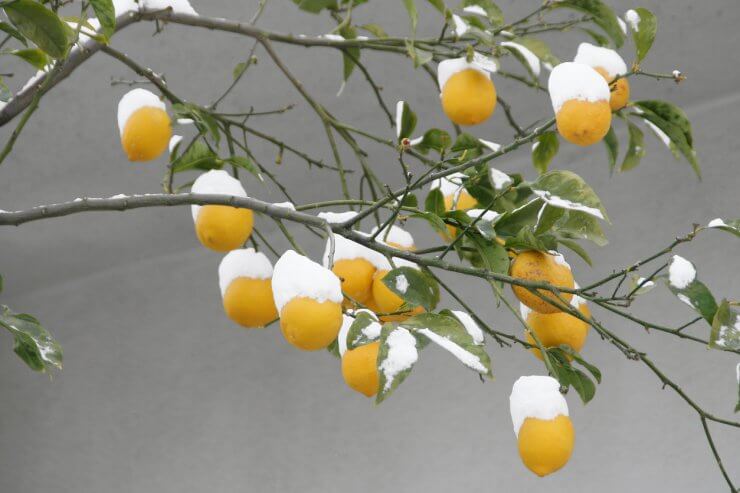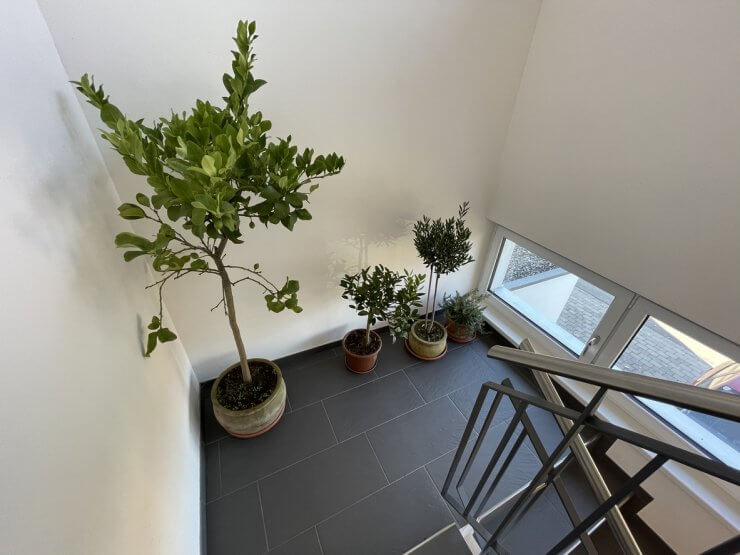
Lemon tree with snow
Lemon trees are the cold-hardiest of all the citrus. Even so, they’re not crazy about cold weather. Some varieties are cold-hardy down to 20 degrees F, but even trees planted outdoors deserve a little TLC when the weather turns cold.
The first step is to have chosen a lemon tree suited to your growing zone. The next step is to help your tree get ready for winter—if you’re in an area where the temperature can drop below freezing.
Here’s how to get your outdoor-planted lemon trees ready for a potential freeze.
Final Harvest
Pick any ripe lemons still on the tree before the first frost. Any time the temperature drops below 30 degrees F, that’s a sign that any lemons left on the tree are probably ruined—unless you’re growing Eureka or Lisbon lemons. They have thicker rinds and the fruit can tolerate a temperature drop as low as 28 degrees F.
Clean up any leaf litter around the tree and remove dead wood. Don’t prune—save that for spring, after the last frost.
Water
Give your trees regular waterings. It’s easier for them to deal with freezing temperatures if they already have moist soil; moist soil will freeze but it won’t hurt the roots. If there’s no rain, give young trees about an inch of water a week; older trees should get 1 to 2 inches of water a week.
Fertilize
Lemon trees less than 2 years old should not get fertilizer over the winter. Fertilize older trees only if their foliage starts to lighten, using a fertilizer specifically formulated for citrus trees.
Wrap/Cover
Wrap your tree’s trunk with several layers of cardboard to provide an insulating barrier against frost. Wrap the trunk from just under the tree’s main limbs all the way to the ground. Secure the wrap with duct tape. You can also wrap the trunk with burlap or blankets, but be sure to check the wrap regularly for insect infestation. Keep this “sweater” on your tree’s trunk until the last frost has passed.
If you’re in an area prone to cold snaps, you can build a frame around the tree that you can cover with a tarp or plastic sheeting. Some garden centers also carry frost cloths that you can drape over your tree and leave on without harming the tree. However you cover your tree, make sure the cover reaches all the way to the ground so you’re holding in as much heat from the earth as possible and keeping out the cold air.
There are some products, such as CloudCover, that you can use to spray your tree’s leaves to protect it from cold. It creates a thin film that insulates the leaves but still lets the tree breathe. Ask your local extension center or garden center for recommendations for the best way to protect your planted lemon trees.
If you live in an area where the temperature drops below freezing for an extended time, you might want to consider growing your lemon tree in a container, so you can bring it indoors when the weather turns cold.
Container Trees

Various fruit trees, including lemons, overwintering indoors
For your lemon trees growing in containers, you can phase them into being totally indoors over the course of a month before the first expected frost.
For two weeks, leave your tree in full sunlight in the morning and move it into the shade for the afternoon. For the next two weeks, leave it in the shade all day.
Before you bring your potted tree into the house for the winter, you want to debug it. Get out the garden hose in the morning and give your tree a full blasting of water from the top to the base of the trunk. Let it dry naturally, then spray the tree with insecticidal soap to catch any insects that may have avoided the hose. You don’t want to bring aphids or scale into the house if you can help it.
Put your tree in a bright, sunny, draft-free area of your home. Your tree will be happiest with at least eight hours of bright sunlight a day, and a temperature between 55 and 68 degrees F. A partially heated sunroom or a bright south-facing window would be ideal.
Water your tree when the top 2 to 3 inches of the soil become dry; you want to keep the root ball from drying out.
Fertilize the foliage of your lemon tree. Use a balanced liquid fertilizer that contains micronutrients. Dilute it to half-strength and spray once a month.
To prevent pest infestations, wash your tree’s leaves every week. Use a soft, damp cloth to remove dust and any pests that sneak in. If necessary, apply insecticidal soap.
Wait until after the last frost in your area before you prune your container tree. Cut out any dead wood and any branches that are rubbing each other. Prune enough to open the middle of the tree to sunlight and better airflow.
When the weather is good enough to set your tree outside again, reverse the acclimation process—but bring your tree back inside at night for the first week.
Have you successfully overwintered your lemon trees? Please share your tips in with us.


 Previous
Previous

